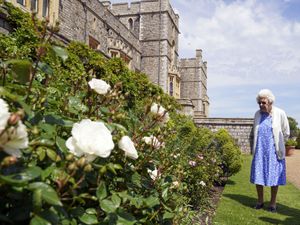Windsor Castle: Queen's final resting place first built by William the Conqueror nearly 1,000 years ago
Windsor Castle, the oldest inhabited castle in the world, will be the final resting place of Queen Elizabeth II - and it will be a fitting location after a lifetime of service to her country.

One of the Queen's official residences and the place she called home, the 13-acre castle in Berkshire will be the site of Elizabeth's family's final goodbyes before she is laid to rest this afternoon after her death on September 8.
Elizabeth will be buried within the King George VI Memorial Chapel, named after her father who died in 1952.
She will join her father and Queen Elizabeth the Queen Mother, who died 20 years ago, as well as her sister Princess Margaret, who had her ashes placed in the chapel after her death in 2002.
There could be fewer more fitting resting places for the United Kingdom's longest-serving monarch, as the castle has served as home for 40 British monarchs and has been a symbol of the royal family for almost a thousand years.
William the Conqueror began building the castle in 1070, having chosen the site high above the Thames, and it was finished 16 years later. Its strategic location as well as its proximity to the capital and prime hunting grounds made it a sensible head of operations for the monarchy.
Henry I, II and III made their own alterations as they inherited the castle, but the most sweeping changes were made by Edward III in the 14th Century.
The Royal Collection Trust, which managed the public openings of the Queen's residences, says: "[Edward] transformed Windsor from a military fortification to a gothic palace, spending £50,000 in the process. The gothic style of building with pointed arches has remained the predominant architectural style at Windsor for 800 years.
"His aim was to create one large palace which contained both the state apartments for official and ceremonial business, and the King and Queen’s own private apartments, in a single unified residence.
"The work was not completed by the time of Edward III’s death, and continued for another six years into the reign of his grandson and successor Richard II."
Hundreds of years later Windsor was used by Oliver Cromwell as his headquarters, and as a prison for captured royalists.
After the monarchy was restored in 1660, Charles II and later Georges III and IV made their own tweaks to Windsor Castle, furthering its transformation into an imposing Gothic palace.
Windsor was a favourite of Queen Victoria and Prince Albert, enjoying the position of principal palace of the British monarchy and focus of the British empire as it was in the 19th Century.
King George VI and the Queen Mother, Elizabeth's parents, considered Windsor their home and even during the Second World War would join the young princesses there at evenings and weekends.
The young woman who went on to become Queen Elizabeth II, and her sister Princess Margaret, were brought up at Windsor and every Christmas they would perform a pantomime in the Waterloo Chamber.
The Royal Collection Trust says: "The castle survived the war unscathed, but was to suffer greatly 50 years later on November 20, 1992, when a fire broke out in Queen Victoria’s private chapel.
"The fire quickly engulfed the roof spaces, destroying the ceilings of St George’s Hall and the Grand Reception Room, as well as gutting the private chapel, the State Dining Room and the Crimson Drawing Room in particular.
"The long process of repair and restoration began immediately, with The Duke of Edinburgh chairing the restoration committee. The areas that were most badly damaged, such as St George’s Hall, were redesigned in a modern gothic style, while the other parts were restored to the condition in which George IV had left them.
"The cost, £37m, was largely met from the proceeds of admissions to the castle precincts and to Buckingham Palace, which was opened to the public for the first time in 1993. The work took five years to complete."





